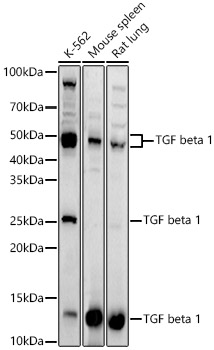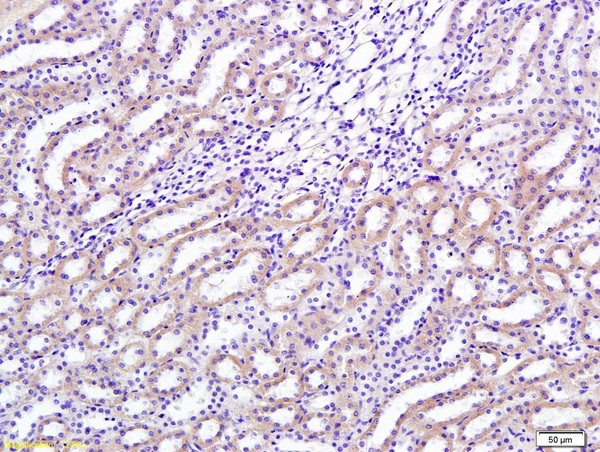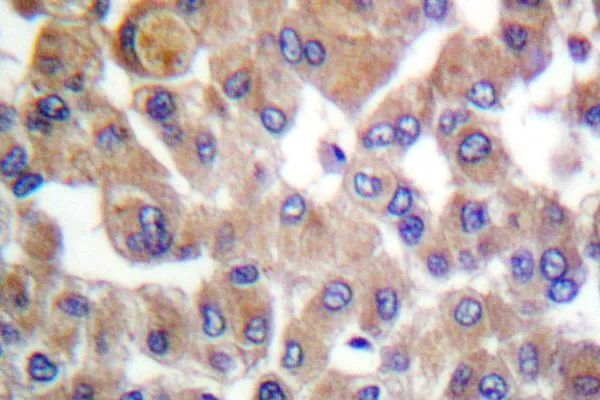TGF beta antibody [TB21]
GTX76527
ApplicationsFlow Cytometry, Western Blot, ELISA, ImmunoHistoChemistry, ImmunoHistoChemistry Frozen, ImmunoHistoChemistry Paraffin
Product group Antibodies
TargetTGFB1
Overview
- SupplierGeneTex
- Product NameTGF beta antibody [TB21]
- Delivery Days Customer9
- ApplicationsFlow Cytometry, Western Blot, ELISA, ImmunoHistoChemistry, ImmunoHistoChemistry Frozen, ImmunoHistoChemistry Paraffin
- CertificationResearch Use Only
- ClonalityMonoclonal
- Clone IDTB21
- Concentration1 mg/ml
- ConjugateUnconjugated
- Gene ID7040
- Target nameTGFB1
- Target descriptiontransforming growth factor beta 1
- Target synonymsCED, DPD1, IBDIMDE, LAP, TGF-beta1, TGFB, TGFbeta, transforming growth factor beta-1 proprotein, TGF-beta-1, latency-associated peptide, prepro-transforming growth factor beta-1, transforming growth factor beta1
- HostMouse
- IsotypeIgG1
- Scientific DescriptionThis gene encodes a member of the transforming growth factor beta (TGFB) family of cytokines, which are multifunctional peptides that regulate proliferation, differentiation, adhesion, migration, and other functions in many cell types. Many cells have TGFB receptors, and the protein positively and negatively regulates many other growth factors. The secreted protein is cleaved into a latency-associated peptide (LAP) and a mature TGFB1 peptide, and is found in either a latent form composed of a TGFB1 homodimer, a LAP homodimer, and a latent TGFB1-binding protein, or in an active form composed of a TGFB1 homodimer. The mature peptide may also form heterodimers with other TGFB family members. This gene is frequently upregulated in tumor cells, and mutations in this gene result in Camurati-Engelmann disease.[provided by RefSeq, Oct 2009]
- Storage Instruction-20°C or -80°C,2°C to 8°C
- UNSPSC12352203
References
- Sampaio LP, Hilgert GSL, Shiju TM, et al. Topical Losartan and Corticosteroid Additively Inhibit Corneal Stromal Myofibroblast Generation and Scarring Fibrosis After Alkali Burn Injury. Transl Vis Sci Technol. 2022,11(7):9. doi: 10.1167/tvst.11.7.9Read this paper
- Casagrande N, Borghese C, Agostini F, et al. In Ovarian Cancer Multicellular Spheroids, Platelet Releasate Promotes Growth, Expansion of ALDH+ and CD133+ Cancer Stem Cells, and Protection against the Cytotoxic Effects of Cisplatin, Carboplatin and Paclitaxel. Int J Mol Sci. 2021,22(6). doi: 10.3390/ijms22063019Read this paper
- Licini C, Farinelli L, Cerqueni G, et al. Heterotopic ossification in a patient with diffuse idiopathic skeletal hyperostosis: Input from histological findings. Eur J Histochem. 2020,64(4). doi: 10.4081/ejh.2020.3176Read this paper
- de Oliveira RC, Tye G, Sampaio LP, et al. TGFβ1 and TGFβ2 proteins in corneas with and without stromal fibrosis: Delayed regeneration of apical epithelial growth factor barrier and the epithelial basement membrane in corneas with stromal fibrosis. Exp Eye Res. 2021,202:108325. doi: 10.1016/j.exer.2020.108325Read this paper
- Zhou Y, Que KT, Tang HM, et al. Anti-CD206 antibody-conjugated Fe(3)O(4)-based PLGA nanoparticles selectively promote tumor-associated macrophages to polarize to the pro-inflammatory subtype. Oncol Lett. 2020,20(6):298. doi: 10.3892/ol.2020.12161Read this paper
- Li L, Lin L, Veeraraghavan J, et al. Therapeutic role of recurrent ESR1-CCDC170 gene fusions in breast cancer endocrine resistance. Breast Cancer Res. 2020,22(1):84. doi: 10.1186/s13058-020-01325-3Read this paper
- Carlin GL, Bodner K, Kimberger O, et al. The role of transforming growth factor-ß (TGF-ß1) in postmenopausal women with pelvic organ prolapse: An immunohistochemical study. Eur J Obstet Gynecol Reprod Biol X. 2020,7:100111. doi: 10.1016/j.eurox.2020.100111Read this paper
- Grabias BM, Konstantopoulos K. Notch4-dependent antagonism of canonical TGF-β1 signaling defines unique temporal fluctuations of SMAD3 activity in sheared proximal tubular epithelial cells. Am J Physiol Renal Physiol. 2013,305(1):F123-33. doi: 10.1152/ajprenal.00594.2012Read this paper
- Lee E, Lee BB, Ko E, et al. Cohypermethylation of p14 in combination with CADM1 or DCC as a recurrence-related prognostic indicator in stage I esophageal squamous cell carcinoma. Cancer. 2013,119(9):1752-60. doi: 10.1002/cncr.27948Read this paper
- Insalaco L, Di Gaudio F, Terrasi M, et al. Analysis of molecular mechanisms and anti-tumoural effects of zoledronic acid in breast cancer cells. J Cell Mol Med. 2012,16(9):2186-95. doi: 10.1111/j.1582-4934.2012.01527.xRead this paper






